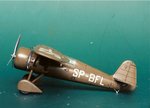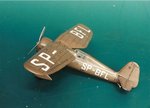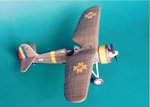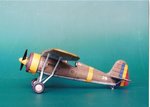First I'll let you into a little secret. As I take you on this journey you will discover that Polish Khaki and Olive Drab are practically the same. The German Brown Violet is also very similar and is often used as the main component to mix Polish Khaki.
Many khaki type colours are based on a mixture of Lamp Black and Yellow Ochre. Add Iron Oxide (Red Ochre) and it becomes browner. Other pigments such as Chromium Oxide can be added to modify the colour. Chinese Blue is sometimes used to darken it. Polish Khaki, so I am told, is based on Prussian Blue and Yellow Ochre. This combination gives Olive Green so there were probably other pigments in the mix as well. It had a reputation for fading quickly to a brownish colour. Perhaps the Prussian Blue had something to do with this. It was this fading that led to the introduction of a new version of khaki in the late 1930s. These two versions of khaki are often referred to as early and late. There is a lot of anecdotal evidence that the late version was greener than the early. Perhaps it just looked greener compared to the faded early khaki.
Early Khaki.
Restoration work on Krakow's PZL P.11c revealed the colours faded khaki FS30118 and FS 30108/FS20122 in hidden areas. This faded khaki matches Humbrol H142 – Field Drab. The second colour found in the protected areas, and which I assume to be closer to the original colour when newly applied, can be obtained by adding 8% H163 (green).to H142. Now RAF Dark Earth
is usually described as FS30118 and some people do use Dark Earth for Polish Khaki but it must be remembered that the FS system is not a continuous scale of colours and FS30118 is the nearest match to H142. When seen together Field Drab and Dark Earth are in fact very close, Field Drab being slightly greener.
Unfortunately, H142 is no longer manufactured by Humbrol and there is no exact match for it that I know of in any other manufacture's range. (Actually this is not quite true but I will come to that at the end.) Beware of comparison charts as often the equivalents are only nearest matches, not exact ones. However, all is not lost. H155 Olive Drab is a darker shade of Field Drab and adding some white to it will produce a close enough match to H142 to satisfy most people. You could probably get away with using H155 as I don't think anyone would notice as I would not be able to tell the difference unless I had the two together to compare.
Late Khaki.
There was much anecdotal evidence that the khaki used in the late 1930s on aircraft such as the PZL P.37 Łoś was different from that used earlier, in particular greener. This has provoked much debate over the years as to whether the colour was really different or if it just looked greener because it had no faded and so on. The most up-to-date opinions of Polish historians are found in the instructions of Mirage's P.23 Karaś kit.
"Preserved fragments of PZL P23s seem to prove the theory that the PZL factory at first used a khaki paint composed of FS20122 and FS30108. Later, the PZL factory changed the khaki colour to a greener shade - FS 34087. The colour used earlier most likely bleached quickly and in doing so lost its camouflaging properties and (probably) this is why the recipe for mixing the pigments in the paint was changed. The new khaki colour was most likely used for painting export aircraft and new types such as the PZL P37 Los or the PZL P43. This seems to confirm the colour photographs taken by the Germans at Okęcie in 1939. We managed to get hold of a fragment of paint from a PZL P37B Los and on the basis of this sample; we selected a mixture of Vallejo paints. The new khaki colour was most likely used on the late-series Karas B and most likely also on refurbished Karas As, and other aircraft repainted as the need arose. As of this moment, we've not been able to discover what colour the interior of the Karas was painted. No information on this subject has survived; we've not been able to find any artefacts. Studying photos, we can make out that the interior is painted in some dark colour, and neither silver nor light blue. The fragments of the P.23 interior exhibited from time to time at the Aviation Museum in Kraków were painted a dark greyish blue. Summing up, the prototypes and early production examples were probably painted silver. Later production machines were probably painted dark greyish-blue or khaki green. The 'shelves' between crew members were painted khaki green. The most likely variant: walls painted dark greyish-blue, the floor black. All equipment, such as the camera, radio, bomb sight, were left in the colours that they were when they left the factories from which they originally came. Stencils (lit. 'utilisation lettering') (on the decal sheet nos. 20, 21, 22, 23) were probably not painted on Karaś. As; we've left them on the sheet as they might well have been applied when the aircraft were being refurbished. An example might be the inscription "NIE DEPTAC" (do not tread) which can be seen on a/c no. 44.30."
Mirage is the Polish agent for Vallejo and now only give mixtures from this range. Out of curiosity I obtained them to see what they produced. The colours, black, chestnut brown, yellow, and two greens, are not what I would expect to produce khaki. One of the greens is like hair dye, leaving the bristles of my paint brush green. I got what I expected, three slightly different shades of chocolate brown with a horrible dirty bottle green cast. When I put them through an airbrush the first layer paint appeared dark green turning to dark brown as the thickness of paint built up. The overspray was also a dirty bottle green. Nothing like the olive green of the illustrations on the instruction sheet which I assume is meant to represent the sort of colour you want. For a while I thought that these mixtures might have been made from a different range of paints and simply translated to the nearest Vallejo equivalents. Frankly I think you would be wasting your time and your money if you buy these paints for this purpose. (No complaints about the paint, it's the colours that are at fault.) There are easier and cheaper ways to get the right colour.
FS 34087. is Olive Drab. Mirage now have a pack of Vallejo paints for mixing the PZL colours
Internetowy sklep i portal modelarski modelarstwo, modele do sklejania, warhammer: WCM - Warszawskie Centrum Modelarskie.
In it they include Vallejo 70887/093 for Late Khaki in place of the mix they gave in the model kit instructions. This matches exactly Humbrol 155 Olive Drab although Vallejo call it Brown Violet. Humbrol's Olive Drab is of the brown type and looks to my eyes, a little too much on the brown side, not what someone would describe as green or greenish. I would prefer to use a greener version of Olive Drab such as White Ensign's ACUS15 Olive Drab 41. This has more of a green colour to it and looks more like the olive colour of the instruction sheet illustrations.
Polish Light Blue.
This is a distinct blue/grey colour something like a paler version of Humbrol 145 Medium Grey. Sometimes RLM 65 has been recommended as a substitute. It is too blue and too bright. Polish Light Blue is more like RLM 76. The Russian AMT-17 is much closer than RLM 65 but a little darker. I could not find anything in off the self that matches it exactly. The plastic top of Tamiya XF23 is very close. That's the colour of the plastic cap not the contents. The paint is darker and bluer. The nearest Humbrol colour is H127 US Ghost Gray. I was able to get an almost exact match by adding some H89 Middle Blue. I had to make the mix slightly lighter as it dries a darker shade. I should think that there are many other combinations of grey and blue that would give correct colour.
Interior Blue/Grey.
For the blue/grey colour used on the interior Mirage recommends Vallejo 005 which is USN Intermediate Blue, Humbrol H144 can be substituted.
The Good News.
Accurately matched authentic Polish Colours are available. They are acrylics made by Agama but are exclusive to the Jadar Shop in Warsaw.
Agama - JadarHobby Shop Sklep Modelarski
P4 is Polish Khaki and matches H142. It also matches the khaki paint on pieces of Karaś wreckage as well as the old paint uncovered during the P.11c restoration.
P5 is Polish Light Blue. There are some other colours as well used on the Lublins and the peculiar greenish grey used on naval aircraft. The also have Czech, French and Italian colours in their range.
Below the real thing. Both models painted with Agama Polish Khaki and Light Blue.
Many khaki type colours are based on a mixture of Lamp Black and Yellow Ochre. Add Iron Oxide (Red Ochre) and it becomes browner. Other pigments such as Chromium Oxide can be added to modify the colour. Chinese Blue is sometimes used to darken it. Polish Khaki, so I am told, is based on Prussian Blue and Yellow Ochre. This combination gives Olive Green so there were probably other pigments in the mix as well. It had a reputation for fading quickly to a brownish colour. Perhaps the Prussian Blue had something to do with this. It was this fading that led to the introduction of a new version of khaki in the late 1930s. These two versions of khaki are often referred to as early and late. There is a lot of anecdotal evidence that the late version was greener than the early. Perhaps it just looked greener compared to the faded early khaki.
Early Khaki.
Restoration work on Krakow's PZL P.11c revealed the colours faded khaki FS30118 and FS 30108/FS20122 in hidden areas. This faded khaki matches Humbrol H142 – Field Drab. The second colour found in the protected areas, and which I assume to be closer to the original colour when newly applied, can be obtained by adding 8% H163 (green).to H142. Now RAF Dark Earth
is usually described as FS30118 and some people do use Dark Earth for Polish Khaki but it must be remembered that the FS system is not a continuous scale of colours and FS30118 is the nearest match to H142. When seen together Field Drab and Dark Earth are in fact very close, Field Drab being slightly greener.
Unfortunately, H142 is no longer manufactured by Humbrol and there is no exact match for it that I know of in any other manufacture's range. (Actually this is not quite true but I will come to that at the end.) Beware of comparison charts as often the equivalents are only nearest matches, not exact ones. However, all is not lost. H155 Olive Drab is a darker shade of Field Drab and adding some white to it will produce a close enough match to H142 to satisfy most people. You could probably get away with using H155 as I don't think anyone would notice as I would not be able to tell the difference unless I had the two together to compare.
Late Khaki.
There was much anecdotal evidence that the khaki used in the late 1930s on aircraft such as the PZL P.37 Łoś was different from that used earlier, in particular greener. This has provoked much debate over the years as to whether the colour was really different or if it just looked greener because it had no faded and so on. The most up-to-date opinions of Polish historians are found in the instructions of Mirage's P.23 Karaś kit.
"Preserved fragments of PZL P23s seem to prove the theory that the PZL factory at first used a khaki paint composed of FS20122 and FS30108. Later, the PZL factory changed the khaki colour to a greener shade - FS 34087. The colour used earlier most likely bleached quickly and in doing so lost its camouflaging properties and (probably) this is why the recipe for mixing the pigments in the paint was changed. The new khaki colour was most likely used for painting export aircraft and new types such as the PZL P37 Los or the PZL P43. This seems to confirm the colour photographs taken by the Germans at Okęcie in 1939. We managed to get hold of a fragment of paint from a PZL P37B Los and on the basis of this sample; we selected a mixture of Vallejo paints. The new khaki colour was most likely used on the late-series Karas B and most likely also on refurbished Karas As, and other aircraft repainted as the need arose. As of this moment, we've not been able to discover what colour the interior of the Karas was painted. No information on this subject has survived; we've not been able to find any artefacts. Studying photos, we can make out that the interior is painted in some dark colour, and neither silver nor light blue. The fragments of the P.23 interior exhibited from time to time at the Aviation Museum in Kraków were painted a dark greyish blue. Summing up, the prototypes and early production examples were probably painted silver. Later production machines were probably painted dark greyish-blue or khaki green. The 'shelves' between crew members were painted khaki green. The most likely variant: walls painted dark greyish-blue, the floor black. All equipment, such as the camera, radio, bomb sight, were left in the colours that they were when they left the factories from which they originally came. Stencils (lit. 'utilisation lettering') (on the decal sheet nos. 20, 21, 22, 23) were probably not painted on Karaś. As; we've left them on the sheet as they might well have been applied when the aircraft were being refurbished. An example might be the inscription "NIE DEPTAC" (do not tread) which can be seen on a/c no. 44.30."
Mirage is the Polish agent for Vallejo and now only give mixtures from this range. Out of curiosity I obtained them to see what they produced. The colours, black, chestnut brown, yellow, and two greens, are not what I would expect to produce khaki. One of the greens is like hair dye, leaving the bristles of my paint brush green. I got what I expected, three slightly different shades of chocolate brown with a horrible dirty bottle green cast. When I put them through an airbrush the first layer paint appeared dark green turning to dark brown as the thickness of paint built up. The overspray was also a dirty bottle green. Nothing like the olive green of the illustrations on the instruction sheet which I assume is meant to represent the sort of colour you want. For a while I thought that these mixtures might have been made from a different range of paints and simply translated to the nearest Vallejo equivalents. Frankly I think you would be wasting your time and your money if you buy these paints for this purpose. (No complaints about the paint, it's the colours that are at fault.) There are easier and cheaper ways to get the right colour.
FS 34087. is Olive Drab. Mirage now have a pack of Vallejo paints for mixing the PZL colours
Internetowy sklep i portal modelarski modelarstwo, modele do sklejania, warhammer: WCM - Warszawskie Centrum Modelarskie.
In it they include Vallejo 70887/093 for Late Khaki in place of the mix they gave in the model kit instructions. This matches exactly Humbrol 155 Olive Drab although Vallejo call it Brown Violet. Humbrol's Olive Drab is of the brown type and looks to my eyes, a little too much on the brown side, not what someone would describe as green or greenish. I would prefer to use a greener version of Olive Drab such as White Ensign's ACUS15 Olive Drab 41. This has more of a green colour to it and looks more like the olive colour of the instruction sheet illustrations.
Polish Light Blue.
This is a distinct blue/grey colour something like a paler version of Humbrol 145 Medium Grey. Sometimes RLM 65 has been recommended as a substitute. It is too blue and too bright. Polish Light Blue is more like RLM 76. The Russian AMT-17 is much closer than RLM 65 but a little darker. I could not find anything in off the self that matches it exactly. The plastic top of Tamiya XF23 is very close. That's the colour of the plastic cap not the contents. The paint is darker and bluer. The nearest Humbrol colour is H127 US Ghost Gray. I was able to get an almost exact match by adding some H89 Middle Blue. I had to make the mix slightly lighter as it dries a darker shade. I should think that there are many other combinations of grey and blue that would give correct colour.
Interior Blue/Grey.
For the blue/grey colour used on the interior Mirage recommends Vallejo 005 which is USN Intermediate Blue, Humbrol H144 can be substituted.
The Good News.
Accurately matched authentic Polish Colours are available. They are acrylics made by Agama but are exclusive to the Jadar Shop in Warsaw.
Agama - JadarHobby Shop Sklep Modelarski
P4 is Polish Khaki and matches H142. It also matches the khaki paint on pieces of Karaś wreckage as well as the old paint uncovered during the P.11c restoration.
P5 is Polish Light Blue. There are some other colours as well used on the Lublins and the peculiar greenish grey used on naval aircraft. The also have Czech, French and Italian colours in their range.
Below the real thing. Both models painted with Agama Polish Khaki and Light Blue.




